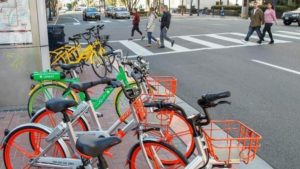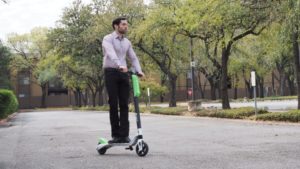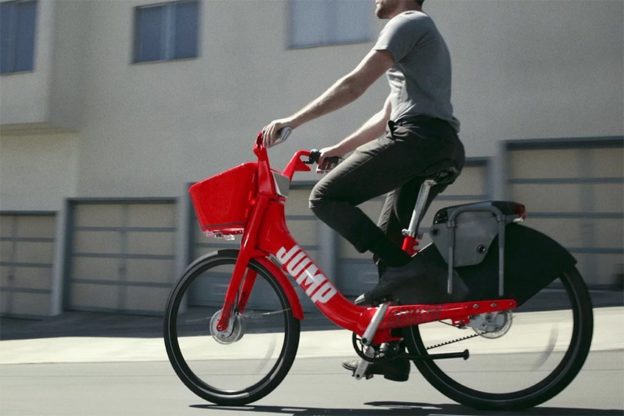The Sacramento region continues to move towards the launch of bike share operations, but the process has not been smooth or without surprises (hint: get ready for shared e-scooters).
We have a strong interest in the potential of bike share as a means for replacing car trips with bike trips: fewer car trips means cleaner air for everyone, while more bikes on the road improves safety for all roadway users. The rapidly evolving model for delivering bike share, including shared mobility devices other than bikes, is being felt in our region, as local governments work hard to keep up. Here’s the latest news.
Sacramento regulates
On Mar. 21, the Sacramento City Council approved an ordinance that sets standards for bike share businesses wanting to operate in Sacramento, with different impacts on different bike share providers.
Sacramento’s new ordinance requires bikes to be equipped with locks to allow locking to a bike rack, a requirement that would force operators like LimeBike and Spin, which only deploy self-locking bikes, to redesign their bikes in order to qualify for an operating permit.

To prevent bike share bikes from displacing personally owned bikes from bike racks, bike share businesses must provide 1.5 public bike parking spaces (usable by anyone) for every bike they deploy. The ordinance also prohibits any bicyclist from leaving a bike where it prevents pedestrians from passing through (this applies to personally owned bikes as well as share bikes).
This provision is meant to head off the kinds of problems experienced in places like Washington, D.C, Seattle, Dallas and most recently Coronado, CA, where business and property owners increasingly see self-locking bike share bikes as a public nuisance.
The ordinance also covers shared electric scooters, the newest form of shared mobility technology, and similar shared devices. Providers of shared e-scooters would have to meet all the requirements for bike share businesses.
Sacramento will also require electric bike share bikes to be equipped for a maximum operating speed of 15 MPH. Sacramento is the first U.S. city to impose such a cap, although some European countries have capped e-bike operating speeds at 25 KPH or about 15.5 MPH. The City justifies the cap as a safety feature, however, there is little research to demonstrate the link between e-bike operating speeds and safety.
This requirement will impact JUMP Bike, operator of the SACOG regional bike share system that will launch North America’s largest electric bike share fleet in Sacramento, West Sacramento and Davis this spring. At our request, the City agreed to revisit this provision in a year, once data is available about usage, speeds and crashes. We respect the City’s safety concerns and also want to ensure that City policies are based on data, evidence and best practices.
LimeBike bails on Rancho Cordova and Folsom
Last month the cities of Rancho Cordova and Folsom both issued permits to allow LimeBike to begin operating this spring. And then on Mar. 19, LimeBike announced that it was backing out, citing the impacts of Sacramento’s bike share ordinance.
LimeBike told the cities it had counted on operating in the urban center of Sacramento as the way to make its suburban operations in the east county succeed – which was news to both cities and stakeholders, as LimeBike hadn’t previously stated its intention to operate in Sacramento. Bike share systems typically succeed in denser, more urbanized neighborhoods that can generate enough ridership. We haven’t seen evidence from other cities that entirely suburban settings, like Rancho Cordova and Folsom, can support bike share operations.
West Sacramento gets e-scooters

Early this month, West Sacramento issued a permit to LimeBike to deploy 100 e-scooters in the riverfront area near City Hall and Raley Field. LimeBike currently operates its Lime-S e-scooters in San Francisco, San Jose and San Diego.
State law allows them to be ridden wherever bikes can operate, including bike lanes and off-street bike paths, but not on streets with speed limits over 25 MPH that don’t also bike lanes and never on sidewalks. Riders must be 16 or older, have a driver’s license and wear a helmet.
With very few e-scooters currently being operated in the region, it’s hard to predict the actual impact of LimeBike e-scooters on bicycle transportation, however, we’ll track the roll-out in West Sacramento to ensure that e-scooter users don’t impede trips by bike.
Sacramentans on bikes can probably expect to encounter a few Lime-S e-scooters ridden across the Tower Bridge into downtown Sacramento, even if LimeBike doesn’t have a permit to operate there. But if an e-scooter customer ends in Sacramento and leaves the scooter there, Sacramento has the authority to impound it.

